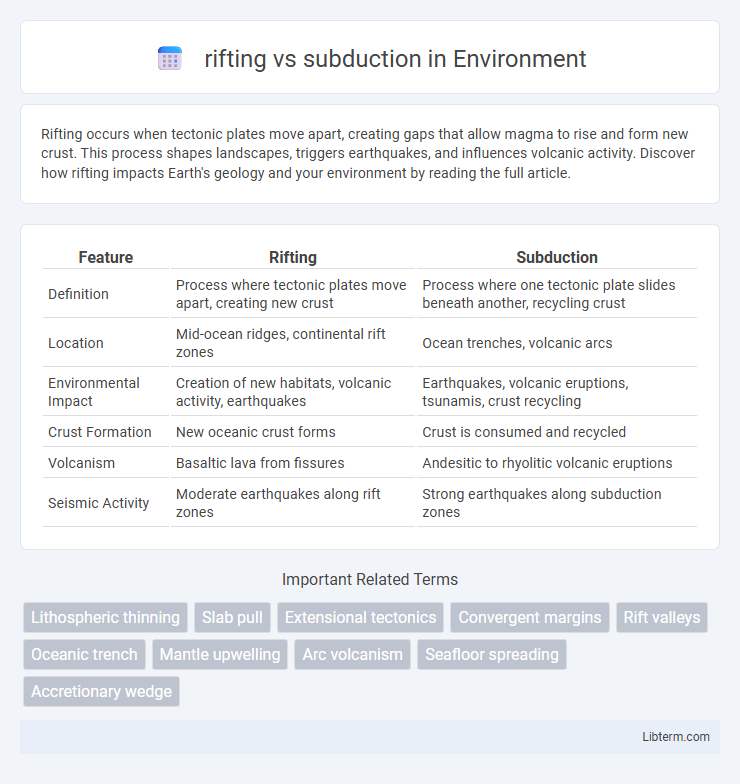Rifting occurs when tectonic plates move apart, creating gaps that allow magma to rise and form new crust. This process shapes landscapes, triggers earthquakes, and influences volcanic activity. Discover how rifting impacts Earth's geology and your environment by reading the full article.
Table of Comparison
| Feature | Rifting | Subduction |
|---|---|---|
| Definition | Process where tectonic plates move apart, creating new crust | Process where one tectonic plate slides beneath another, recycling crust |
| Location | Mid-ocean ridges, continental rift zones | Ocean trenches, volcanic arcs |
| Environmental Impact | Creation of new habitats, volcanic activity, earthquakes | Earthquakes, volcanic eruptions, tsunamis, crust recycling |
| Crust Formation | New oceanic crust forms | Crust is consumed and recycled |
| Volcanism | Basaltic lava from fissures | Andesitic to rhyolitic volcanic eruptions |
| Seismic Activity | Moderate earthquakes along rift zones | Strong earthquakes along subduction zones |
Understanding Rifting and Subduction
Rifting occurs when tectonic plates move apart, causing the Earth's lithosphere to thin and create new ocean basins through seafloor spreading. Subduction involves one tectonic plate sinking beneath another into the mantle, leading to the recycling of crustal material and formation of deep ocean trenches and volcanic arcs. These processes drive plate tectonics, influencing earthquake activity, mountain building, and the dynamic evolution of Earth's surface.
Defining Tectonic Plate Boundaries
Rifting occurs at divergent plate boundaries where tectonic plates move apart, causing the lithosphere to thin and form new crust through volcanic activity. Subduction takes place at convergent boundaries, where one plate is forced beneath another into the mantle, leading to trench formation and intense seismic and volcanic activity. These processes define the fundamental mechanisms of plate interaction and drive the dynamic evolution of Earth's surface.
Mechanisms of Rifting
Rifting occurs when tectonic forces cause the lithosphere to stretch and thin, leading to the formation of faults and fractures that allow the crust to break apart. This extensional process is driven by mantle upwelling and divergent plate boundaries, where magma rises to create new oceanic crust. In contrast to subduction, which involves convergent plates and crustal destruction, rifting promotes crustal creation and the development of rift valleys and mid-ocean ridges.
Processes Involved in Subduction
Subduction involves the downward movement of an oceanic tectonic plate beneath a continental or another oceanic plate, driven by gravitational forces and plate density differences. This process leads to intense geological activities, including volcanic arc formation and deep ocean trench development, caused by melting of the subducted slab and mantle wedge interaction. Subduction zones generate powerful earthquakes and contribute to crust recycling through slab pull and mantle convection dynamics.
Geological Features of Rift Zones
Rift zones are characterized by distinctive geological features such as elongated valleys bordered by normal faults, volcanic activity, and widespread basaltic lava flows resulting from crustal thinning and mantle upwelling. These zones exhibit high heat flow, extensive fissure eruptions, and the development of grabens and horsts, which contrast with the intense compressional forces and deep oceanic trenches found in subduction zones. Rift valleys often host seismic activity related to brittle crustal extension, distinguishing their tectonic environment from the convergent boundaries of subduction systems.
Geological Outcomes of Subduction Zones
Subduction zones generate significant geological outcomes such as deep ocean trenches, volcanic arcs, and intense seismic activity due to the descending oceanic plate beneath a continental or oceanic plate. These zones contribute to crustal recycling, leading to the formation of mountain ranges and island arcs through magmatic processes. The intense pressure and temperature conditions in subduction zones also facilitate the metamorphism of rocks and the creation of economically important mineral deposits.
Associated Earthquakes and Volcanic Activity
Rifting zones experience frequent shallow earthquakes caused by tectonic plates pulling apart, generating volcanic activity characterized by basaltic lava flows from fissure eruptions. Subduction zones produce powerful, often deep-focus earthquakes due to one plate being forced beneath another, triggering explosive volcanic eruptions with andesitic to rhyolitic magma. Earthquake intensity and volcanic explosivity are generally higher in subduction zones compared to the more moderate seismic and volcanic events in rifting environments.
Differences in Crust Formation and Destruction
Rifting occurs at divergent plate boundaries where the lithosphere is pulled apart, leading to the creation of new oceanic crust through upwelling magma and gradual seafloor spreading. Subduction happens at convergent plate boundaries where one tectonic plate sinks beneath another, causing the destruction of oceanic crust as it is recycled into the mantle. This fundamental difference highlights rifting as a process of crust formation, while subduction is primarily a mechanism for crust destruction and recycling.
Global Examples of Rifting and Subduction
The East African Rift Valley represents a prominent example of continental rifting, where the African Plate is splitting into the Somali and Nubian Plates. In contrast, the Pacific Ring of Fire showcases multiple subduction zones, such as the Mariana Trench, where the Pacific Plate subducts beneath the Philippine Sea Plate causing intense seismic activity. These global tectonic settings highlight rifting as a lithospheric extension process and subduction as a convergent boundary interaction driving plate recycling and volcanism.
Environmental and Human Impacts
Rifting zones often lead to increased geothermal activity and volcanic eruptions, which can release hazardous gases and impact air quality in nearby communities. Subduction zones generate powerful earthquakes and tsunamis that pose significant risks to coastal populations, infrastructure, and ecosystems. Both processes contribute to soil fertility through mineral deposition but require careful monitoring to mitigate natural disaster hazards and protect human settlements.
rifting Infographic

 libterm.com
libterm.com